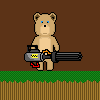ok i admit that sounds confusing but could be because i been staring at the computer for last few hours , i think i can see where my problem is.... i am using an 2d array to create my map not a file(maybe my first mistake?)
here is an example of the map i using atm to test collision
{0,0,0,0,0,0,0,0,0,0,0,0,0,0,0,0,0,0,0,0},
{0,0,0,0,0,0,0,0,0,0,0,0,0,0,0,0,0,0,0,0},
{0,0,0,0,0,0,0,0,0,0,0,0,0,0,0,0,0,0,0,0},
{0,0,0,0,0,0,0,0,0,0,0,0,0,0,0,0,0,0,0,0},
{0,0,0,0,0,0,0,0,0,0,0,0,0,0,0,0,0,0,0,0},
{0,0,0,0,0,0,0,0,0,0,0,0,0,0,0,0,0,0,0,0},
{0,0,0,0,0,0,0,0,0,0,0,1,1,0,1,0,0,0,0,0},
{0,0,0,0,0,0,0,0,0,0,0,2,2,1,2,2,2,2,2,2},
{0,0,0,0,0,0,0,0,0,0,0,2,2,2,2,2,2,2,2,2},
{0,0,0,0,1,0,0,0,1,0,0,2,2,2,2,2,2,2,2,2},
}, 90);
now in the tutorial i used they used 64 as that final value for the size of width and height but then my camera has the map zoomed out far but when i changed it to 90 it made the tiles closer to the screen, but thew now when it comes to the collision the values are all weird, so my tiles width and height is 90x90 but my character is 128x128... i need to try work out the if statements for the collision.... so frustrating , guess this is the problem following an tutorial and then changing things it forces you to learn and understand each line of code to find the problems guess thats supposed to be part of the fun lol






